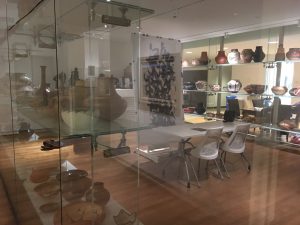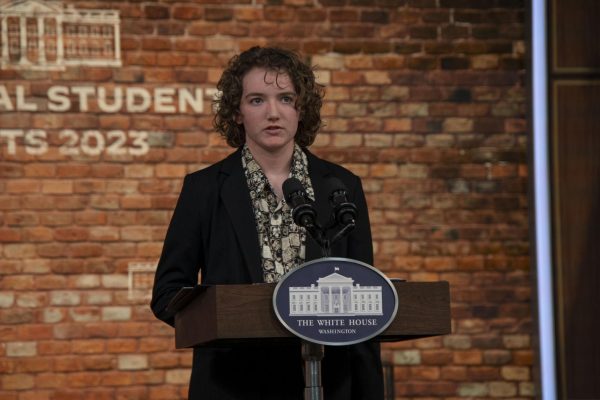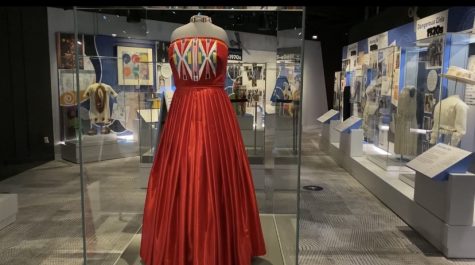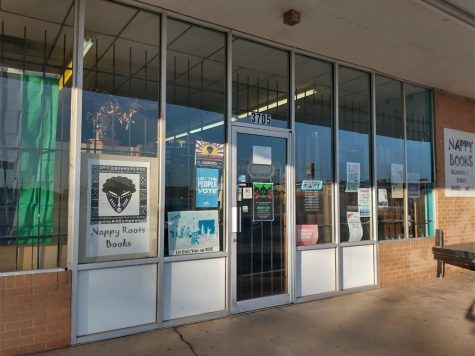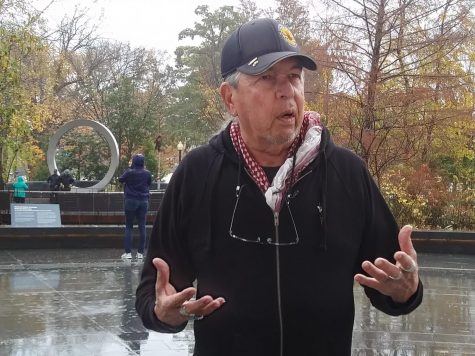Norman art museum crew aims for perfection

Kristi Wyatt, preparator and associate exhibition designer, and Christopher Mackie, assistant preparator, wrap a painting and prepare to place it in a cardboard container. The painting joined a collection of artwork that was sent to Dallas for conservation Monday.
Brad Stevens gets asked what exactly his job is more often than he’d like.
“When I tell people what I do, they’re like, ‘Well, what is that?’ So I always have to explain them what a preparator does.”
They may only be three people, and they may do a job that not a lot of people think much of, but the preparatory crew at the Fred Jones Jr. Museum of Art might be the most important people in the building.
Stevens, chief preparatory and exhibition designer, Kristi Wyatt, preparator and associate exhibition designer and Christopher Mackie, assistant preparator are the team in charge of conserving potential pieces of artwork or sending them to other places of conservation. Last week, a group of paintings was sent to Dallas for further conservation – a process that the preparatory team takes very seriously.
“Part of our purpose is not just to educate, but also to preserve history for future generations to appreciate,” Stevens said. “This includes sending works to conservation to be cleaned and restored to their former glory.”
Many types of damage can occur to paintings, including paint loss, discolored varnish, or accumulation of grime and dust. Depending on the type of artwork, several different techniques can be employed to preserve it. For example, a conservator can go through the process of inpainting, or painting over paint losses, to avoid displaying a piece that has undergone paint losses. Polishing is also a very common technique used to revive the color of sculptures or jewelry.
Generally, the crew will send the art elsewhere to be conserved or prepared for an exhibit of its own. They can also try to conserve the painting themselves if they feel that it is necessary.
“As a painting ages, it can start crazing. Sometimes, some of the pastel will fall off the page,” Wyatt said. “So we try to make an assessment of what can go to conservation, what can’t, and if it’s still viable, that’s something we can do.”
While the conservation of paintings is one of their main tasks, they are also responsible for setting up and taking down exhibits at the museum. The process itself actually takes closer to two years in order to make sure everything is in line.
Stevens said that first, the museum curatorial team brings its ideas to the preparatory team so that they can plan things such as framing, matting, or even picking up the artwork. All the artwork is in the museum a few months before the exhibit, and they set up the art about two or three weeks before the exhibit opens.
The crew makes the quality of the exhibit their utmost priority, which is why the setup process is so important to them.
“You want to make sure everything is in the right place and displayed properly because things in a space have the ability to activate the space,” Mackie said. “So we have to make sure that we’re presenting the work properly to make the visitors’ experience as best as possible.”
The preparatory team has several different resources to maximize the quality of their work. The museum has a storage facility where they keep exhibits as well as other art that is being preserved there. In addition, the museum’s movable walls allow them to free up space to show a timeline or divide it into groups of paintings.
While most visitors of the Fred Jones Museum are concerned primarily with the artwork itself, some do take into account the aesthetic layout of the exhibits as well.
“I think when you first arrive to an art exhibit, the first thing you take in is how it’s presented before you take in the art itself,” said Noah Nichols, a freshman environmental design major. “The producers of the exhibit are what really give the feeling before you get the artist’s impression.”
The preparatory crew is also responsible for preserving some of the art at the museum and sending it for conservation at other exhibits.
“Part of our purpose is not just to educate, but also to preserve history for future generations to appreciate,” Stevens said. “This includes sending works to conservation to be cleaned and restored to their former glory.”
They know it’s not a job visitors care much about, but Stevens, Wyatt, and Mackie are passionate about their work, and they realize the purpose of what they’re doing.
“It’s a unique experience to be an artist and primarily show other people’s work and not your own,” Mackie said. “We have a way of creating without actually creating the paintings or the sculptures. And I think that’s pretty neat.”

